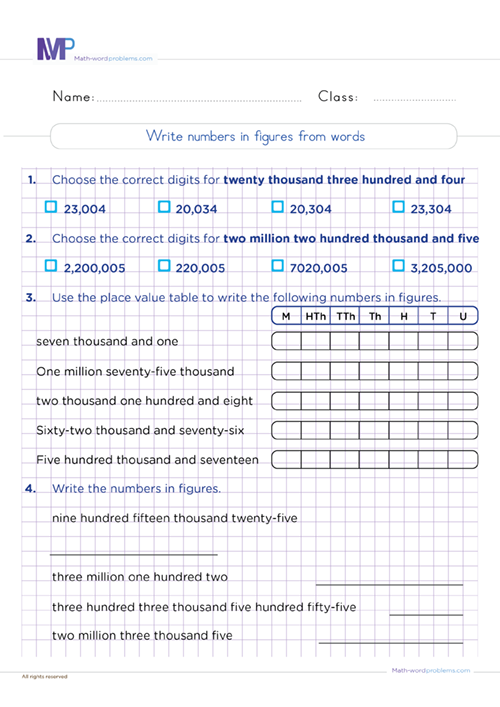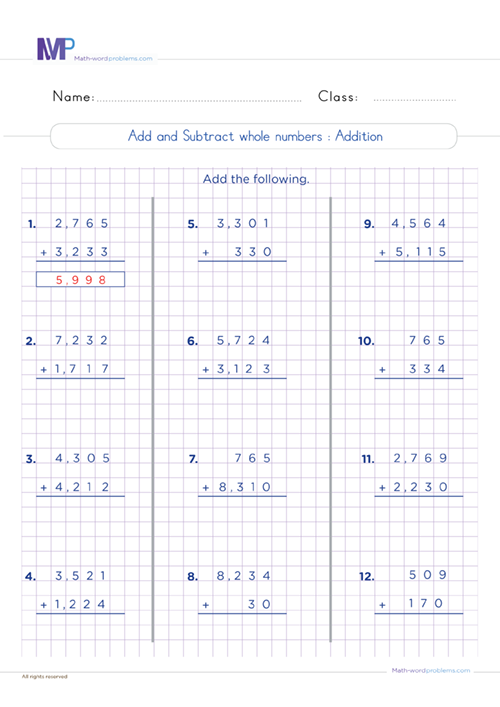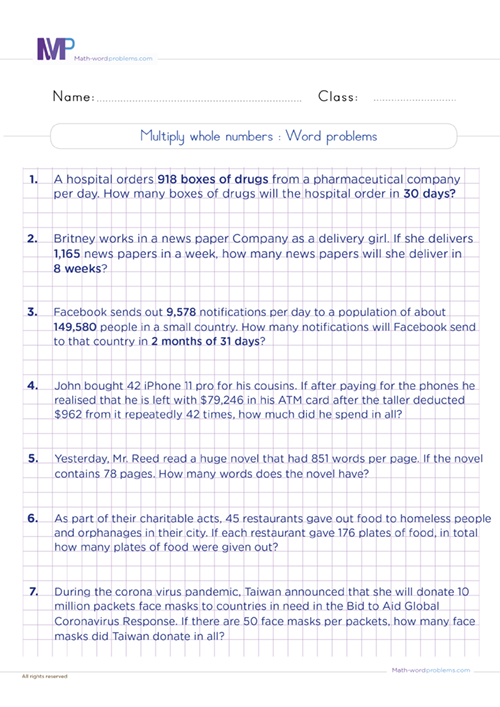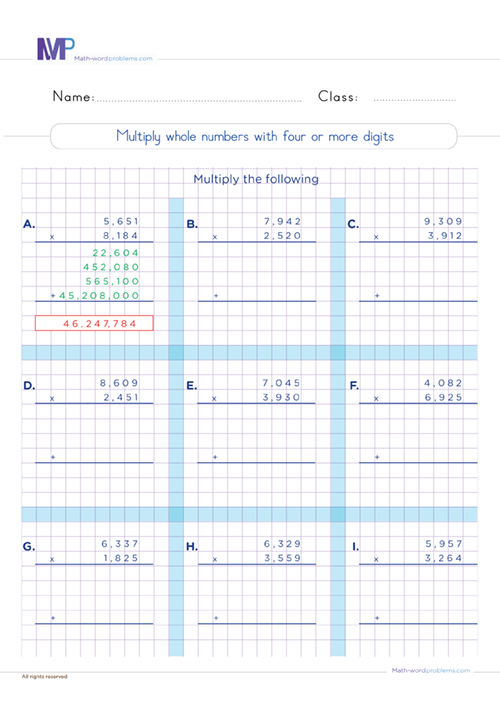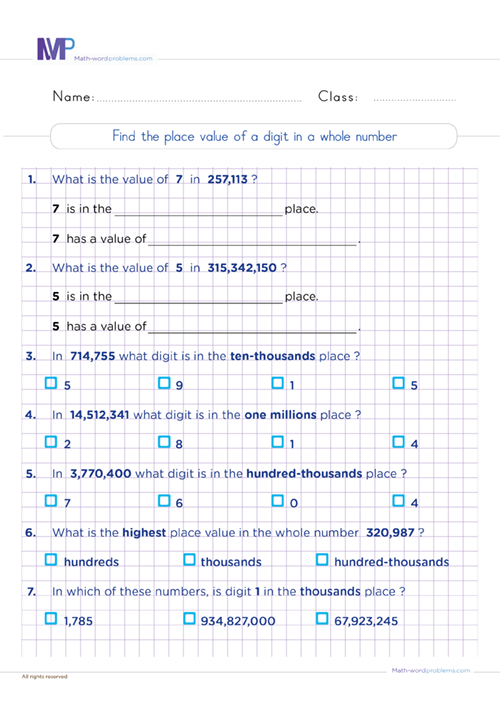 Whole numbers worksheets Grade 6
Whole numbers worksheets Grade 6

- INTRODUCTION
- Download worksheets
- Related Contents
- Mastering whole numbers in words and figures using place val...
Get more contents on Whole numbers for grade 6 questions and Answers...
Available here are fun, engaging whole numbers worksheets Grade 6 designed to enrich 6th graders' counting, addition, and subtraction skills. What are whole numbers?
Whole numbers, sometimes called natural numbers, are part of real numbers that do not include fractions, decimals, or negative numbers but can be positive or zero. We use these numbers (0, 1, 2, 3, 4, 5, etc.) in counting, ordering, measuring, and representing quantities in math and real life, for instance, the number of oranges in a basket, the number of people in a bus, etc.
These whole numbers worksheets include all whole numbers operations such as place value and names for whole numbers, Roman numerals, writing numbers in figures and words, adding, subtracting, and multiplying whole numbers, etc. For each whole number worksheet, we will provide an answer sheet for kids to verify their answers and for teachers to assess kid's progression.
One exciting thing about whole numbers is the unique properties that help us solve math mentally, even without a calculator. These properties include closure, commutative property of addition and multiplication, associative property of addition and multiplication, distributive property of multiplication over addition, and identity Property. In addition, whole numbers have an identity element for both operations, i.e., 0 for addition and 1 for multiplication. We always get the same number back when we add 0 or multiply by 1 to any whole number.
Above all, we will formulate whole numbers exercises with unique patterns so kids can better master the relationship between whole numbers, thus better understanding their properties.
Properties of whole numbers worksheets 6th grade
Your 6th graders will learn how to mentally perform operations on whole numbers by mastering how properties of whole numbers worksheets 6th Grade work. These properties will reveal the uniqueness of whole numbers compared to other numbers like fractions, decimals, etc. One of these unique features of whole numbers is their rules. For instance, the order in which addition and multiplication occur doesn't affect their final answer. However, let's get familiar with the four properties of whole numbers.
- First, the commutative property states that when two numbers are added or multiplied, the answer is the same regardless of the order in which the numbers are added or multiplied. For instance;
3 + 2 = 5 or 2 + 3 = 5
3 x 2 = 6 or 2 x 3 = 6
- Secondly, the associative property states that when three or more numbers are added or multiplied, the answer is the same regardless of how the numbers are grouped. For instance
5 + (3 + 2) = 10 or (5 + 3) + 2 = 10
x (3 x 2) = 30 or (5 x 3) x 2 = 30
- Also, the sum of two numbers times a third number equals the sum of each addend times the third number. For instance,
4 x (6 + 3) = 36 or 4 x 6 + 4 x 3 = 36
- The identity property for addition states that the sum of any number and zero is that number. For instance 7 + 0 = 7. The identity property of multiplication state that the product of any number and one is that number. For instance 9 x 1 = 9
Mastering these properties is, however, a fantastic way to successfully solve all the exercises designed in our whole numbers worksheets Grade 6.
Mastering whole numbers in words and figures using place value skills with whole numbers worksheets Grade 6
Find the best way to keep track of your kid's math progress by encouraging them to engage in mastering whole numbers in words and figures using place value skills with whole numbers worksheets Grade 6. Reading and writing whole numbers using place value skills is a perfect way to enhance kids' math and number sense. As we know, place value is the system we use to assign a value to each digit in a number based on its position. For example, in the number 3652, the digit 3 has a value of 3,000 because it is in the thousands place, the digit 6 has a value of 600 because it is in the hundreds place, the digit 5 has a value of 50 because it is in the tens place. The digit 2 has a value of 2 because it is in the ones place.
Note the following steps while writing whole numbers in words:
- Start from the leftmost digit and group the digits into their place values. Each digit has its position and name. For instance, it can be ones, tens, hundreds, thousands, tens of thousands, etc.
- For a two-digit number or the last but one-digit number, write its value in words followed by a hyphen only if it is not zero or part of a two-digit number between 10 and 19. For example, 12 is written as twelve, but 23 is written as twenty-three.
- We use the word "and" before the last digit. For instance, we write 63 sixty-three and 603 as six hundred and three.
In addition to using place value skills to write numbers in figures and words, you'll realize that the place value concept is essential to learning other math operations like comparing numbers, addition, subtraction, multiplication, and division. For instance, you must pay attention to place value while subtracting, especially when borrowing or regrouping. Above all, using place value can enable us to understand how numbers work and perform calculations more accurately and efficiently.


